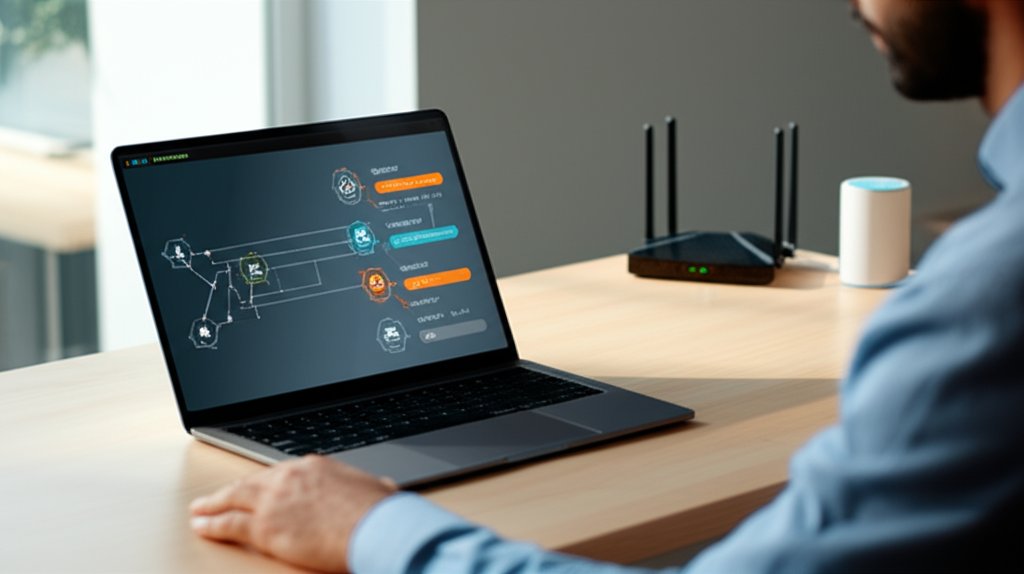Why Automated Security Scans Miss Vulnerabilities: What Small Businesses Need to Know
As a small business owner, safeguarding your online presence, customer data, and operational integrity is, rightly so, a top priority. You might have invested in automated security scans for your website or application, believing this covers your bases. While a smart first step, this reliance can unfortunately create a false sense of complete security. Many critical application security vulnerabilities often bypass these automated checks. These tools are valuable, but they have inherent limitations. Understanding these gaps is crucial for small business owners to take control, identify missed threats, and build a truly resilient digital defense strategy.
Table of Contents
- What are automated security scans, and why do small businesses use them?
- Why can’t automated scans catch all application vulnerabilities?
- What’s a “zero-day” vulnerability, and why do scans miss it?
- How do “business logic flaws” slip past automated scanners?
- What are false positives and false negatives in scanning, and why do they matter?
- Are automated scans still useful, given their limitations?
- Beyond scans, what practical steps can small businesses take to find hidden vulnerabilities?
- What is a “defense-in-depth” strategy, and how does it help application security?
- How can small businesses prioritize their app security efforts effectively?
Frequently Asked Questions
What are automated security scans, and why do small businesses use them?
Automated security scans are software tools designed to automatically check websites and applications for common weaknesses. Think of them as an automated health check for your application’s security, quickly identifying known issues and providing a fundamental assessment. Small businesses rely on them because they are efficient, cost-effective, and require minimal technical expertise to operate, offering a rapid first line of defense against cyber threats.
These tools, often categorized as DAST (Dynamic Application Security Testing) or SAST (Static Application Security Testing) scanners, swiftly pinpoint vulnerabilities like SQL injection or cross-site scripting. They achieve this by comparing your code or running application against extensive databases of known attack patterns. For a small business with limited IT resources, these scans are invaluable for establishing a security baseline, meeting basic compliance requirements, and catching easily exploitable flaws before malicious actors do.
Why can’t automated scans catch all application vulnerabilities?
Automated scans fall short of catching all vulnerabilities primarily because they operate based on predefined rules, signatures, and known patterns. They are exceptionally good at identifying issues that match their programmed knowledge. However, they lack the human capacity to understand complex context, intricate business logic, or to adapt to entirely new, unknown threats. Imagine a highly efficient security robot that can only spot dangers it has been explicitly trained to recognize.
The fundamental limitation lies in their programmatic nature. Scanners do not “think” or “reason” in the human sense; they execute predetermined instructions. This means any vulnerability requiring deeper contextual understanding, advanced attack chaining, or the creative exploitation of a system’s unique design flaws will likely bypass them. While powerful for high-volume checks, they simply do not possess the intuition or adaptability that human security experts bring to the table.
What’s a “zero-day” vulnerability, and why do scans miss it?
A “zero-day” vulnerability is a software flaw that is unknown to the vendor and for which no patch or fix is yet available. It’s termed “zero-day” because developers have had zero days to address it once it’s discovered and potentially exploited in the wild. Automated scans miss these critical flaws precisely because they depend on databases of known vulnerabilities to function; if a threat isn’t on that list, the scanner has no way to identify it.
Consider your antivirus software, which relies on a constantly updated list of known viruses. A zero-day is akin to a brand-new virus that hasn’t been added to that list yet. Since automated scanners operate on similar principles, they simply lack the signature or pattern required to detect a zero-day exploit. This underscores why effective application security against zero-days demands a more proactive and layered defense strategy, rather than solely relying on signature-based detection.
How do “business logic flaws” slip past automated scanners?
Business logic flaws are vulnerabilities deeply embedded in how an application is designed to function, rather than mere coding errors. Scanners struggle immensely with these because they don’t “understand” the specific purpose, intended user flow, or operational rules of your application. An automated tool can verify if a password field is secure, but it cannot discern if your checkout process allows a user to obtain free items by manipulating the steps in an unintended sequence.
For instance, a scanner might confirm that an “admin” portal is protected by robust authentication. However, it wouldn’t recognize if a user could bypass a critical payment step simply by hitting the browser’s back button at a particular moment. These are complex, context-dependent issues unique to your application’s design, and automated tools, with their rigid rule-based approach, are not equipped to identify them. Discovering these often requires meticulous human analysis and creative thinking, mimicking an attacker’s mindset.
What are false positives and false negatives in scanning, and why do they matter?
False positives occur when a scanner flags a non-existent issue, essentially “crying wolf.” They matter significantly because they waste your time and resources investigating phantom threats, diverting attention from genuine concerns. False negatives are far more perilous: these are instances where a scanner misses a real, exploitable vulnerability, providing you with a dangerous, inaccurate sense of security.
False positives can lead to alert fatigue, causing you or your team to disregard genuine warnings amidst the noise of irrelevant alerts. Even worse, false negatives leave critical weaknesses undiscovered, making your application vulnerable to real attacks despite your scanning efforts. It’s like having a smoke detector that frequently alarms for burnt toast (a false positive) but occasionally fails to sound during an actual fire (a false negative). Both scenarios erode trust in the tool and severely undermine its overall effectiveness.
Are automated scans still useful, given their limitations?
Absolutely, automated scans remain highly useful and are an indispensable component of any comprehensive security strategy. While it’s true they can’t catch every single vulnerability, they excel at rapidly identifying common, known weaknesses such as SQL Injection or Cross-Site Scripting, which account for a significant percentage of real-world attack vectors. They serve as an essential first line of defense.
Automated tools provide a vital baseline for your security posture, assist with compliance by generating audit trails, and automate routine checks, thereby saving valuable time and resources for small businesses. They allow you to catch many basic flaws early in the development cycle, preventing them from escalating into more serious and costly problems. Think of them as an indispensable, high-volume sieve that catches the vast majority of larger threats, even if some highly sophisticated ones still slip through. You should not consider skipping them simply because they are not perfect.
Beyond scans, what practical steps can small businesses take to find hidden vulnerabilities?
To uncover hidden vulnerabilities, particularly business logic flaws and contextual weaknesses, small businesses must supplement automated scans with human insight and proactive practices. Relying solely on scans is insufficient; they are merely one tool in your extensive security toolbox.
- Manual Reviews & Basic Checks: Encourage staff (even non-technical ones) to “test” the application with a critical eye. Can they manipulate prices during checkout? Can they access other users’ data by simply changing a number in the URL? Systematically test different user roles and permissions.
- Ethical Hackers/Penetration Testers: If your budget permits, hire a professional to conduct a penetration test. These experts think like attackers, creatively attempting to exploit your application’s unique design and uncover complex, chained vulnerabilities that automated scanners would never find.
- Vendor Due Diligence: If you utilize third-party software or engage a web developer, ask precise questions about their security testing practices. Do they conduct manual code reviews? Do they perform penetration tests on their deliverables?
- Security Awareness Training: Educate your employees about critical threats such as phishing, suspicious links, and safe browsing habits. Human error often presents the easiest and most frequently exploited vulnerability.
These steps empower small business owners to look beyond the surface and truly understand where their digital defenses might be weakest, allowing for targeted remediation.
What is a “defense-in-depth” strategy, and how does it help application security?
A “defense-in-depth” strategy involves implementing multiple layers of security controls, ensuring that if one layer is breached, another is already in place to detect and mitigate the threat. It’s analogous to having several locks and an alarm system on your front door, rather than just one. This layered approach significantly strengthens application security by making it substantially more challenging for attackers to reach your critical data.
For small businesses, practical layers include:
- Web Application Firewalls (WAFs): These act as a protective shield, filtering out malicious traffic and known attack patterns before they even reach your application.
- Strong Passwords & Multi-Factor Authentication (MFA): Essential for all user accounts, MFA adds a crucial extra layer of verification beyond just a password, significantly thwarting unauthorized access attempts.
- Data Encryption: Protect sensitive information both when it’s stored on servers (data at rest) and when it’s being transmitted across networks (data in transit).
- Regular Software Updates: Consistently update all software, plugins, and operating systems to patch known vulnerabilities and ensure you have the latest security features.
- Network Segmentation: Isolate critical systems and sensitive data from less sensitive ones on your network, limiting an attacker’s lateral movement if a breach occurs.
By building these complementary layers, you create a robust barrier that is far more resilient than relying on any single security measure, providing a formidable defense for your application.
How can small businesses prioritize their app security efforts effectively?
Small businesses should prioritize their app security efforts by focusing strategically on what truly matters most: protecting their most critical data, essential business functions, and revenue-generating processes first. Start by identifying your “crown jewels” – the information or systems whose compromise would inflict the most significant damage (financial, reputational, or operational). This systematic approach helps you allocate limited resources wisely for maximum impact.
Here’s a step-by-step approach for small business owners:
- Identify Critical Assets: Determine which data, applications, or services are absolutely vital for your business to operate. Examples include customer payment information, your core e-commerce platform, or proprietary business data.
- Assess Risks: For each critical asset, evaluate the most likely threats it faces and their potential impact. For instance, consider the risk of a data breach impacting customer trust and leading to regulatory fines.
- Implement Basic Safeguards: Ensure you have foundational protections in place for these high-value assets immediately. This includes Multi-Factor Authentication (MFA), a Web Application Firewall (WAF), and regular software updates. These are often the easiest and most impactful wins.
- Address High-Impact Vulnerabilities: If automated scans or manual reviews uncover critical flaws specifically within your most important systems, prioritize and fix those vulnerabilities without delay.
- Continuous Monitoring: Maintain vigilance over your security posture, adapting your strategies as your business evolves and the threat landscape changes. Security is an ongoing process, not a one-time event.
By focusing your energy where it’s needed most, you can achieve maximum protection and peace of mind with the resources you have available.
Related Questions
- What is the OWASP Top 10, and why is it relevant for small businesses?
- How do Web Application Firewalls (WAFs) complement security scans?
- What’s the difference between vulnerability scanning and penetration testing?
Conclusion: A Holistic Approach to Application Security
Automated security scans are undeniably valuable tools, offering crucial efficiency and a strong first line of defense against many common threats. However, as we’ve explored, they are not foolproof. They possess inherent limitations that allow sophisticated threats like zero-days, complex business logic flaws, and contextual vulnerabilities to slip through the cracks, potentially leaving small business owners with a dangerous false sense of security.
For small business owners, the takeaway is clear: achieving true application security demands a holistic, layered approach. It’s about intelligently combining the speed and efficiency of automation with the irreplaceable insight and adaptability of human intelligence. By understanding these inherent gaps, supplementing your automated scans with manual checks, maintaining consistent updates, and implementing a robust “defense-in-depth” strategy, you empower yourself to build a digital fortress that is far more resilient. Take decisive control of your online safety—your business and your customers depend on it.









